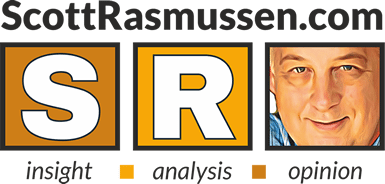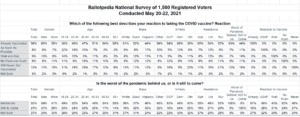Fifty-two percent (52%) of voters now believe that the worst of the pandemic is behind us. That’s up two points from a month ago and up ten points since early in March. The new numbers reflect the highest level of confidence yet measured.
A Ballotpedia national survey found that 21% of voters currently disagree and believe the worst is yet to come. Twenty-seven percent (27%) are not sure.
Public confidence about the pandemic has resembled a roller-coaster ride.
- Following the election last fall, confidence fell sharply. In late November, 68% believed that the worst was still to come. However, following the arrival of COVID-19 vaccines, confidence surged.
- By late January, 33% of voters believed the worst of the pandemic was behind us, while 40% believed the worst was still to come.
- Then, in mid-February, for the first time ever, a plurality of voters believed that the worst was behind us. At that point, 39% took the optimistic view, while 31% gave a more pessimistic answer.
- After that surge, the trend of growing confidence appeared to stall. From mid-February to mid-April, there was little change in public confidence.
- However, since mid-April, optimism has soared once again.
Throughout the pandemic, there has been a vast partisan perception gap. That remains the case today. Sixty-three percent (63%) of Republicans believe the worst is behind us. That view is shared by 46% of Democrats and 43% of Independent voters.
Data released earlier showed that fewer than half of all voters are aware of the new CDC guidelines on mask wearing. There is a partisan divide on this as well. Most Republican voters (56%) are aware of the new CDC guidelines, while most Democrats (57%) are not. Independent voters are evenly divided.
SIGN UP to receive Scott’s free email newsletter.
CHECK OUT Scott’s latest polls.
Note: Neither Scott Rasmussen, ScottRasmussen.com, nor RMG Research, Inc. have any affiliation with Rasmussen Reports. While Scott Rasmussen founded that firm, he left more than seven years ago and has had no involvement since that time.
Methodology
The survey of 1,500 Registered Voters was conducted by Scott Rasmussen using a mixed mode approach from May 20-22, 2021. Field work for the survey was conducted by RMG Research, Inc. Most respondents were contacted online or via text while 216 were contacted using automated phone polling techniques. Online respondents were selected from a list of Registered Voters and through a process of Random Digital Engagement. Certain quotas were applied, and the sample was lightly weighted by geography, gender, age, race, education, internet usage, and political party to reasonably reflect the nation’s population of Registered Voters. Other variables were reviewed to ensure that the final sample is representative of that population.


